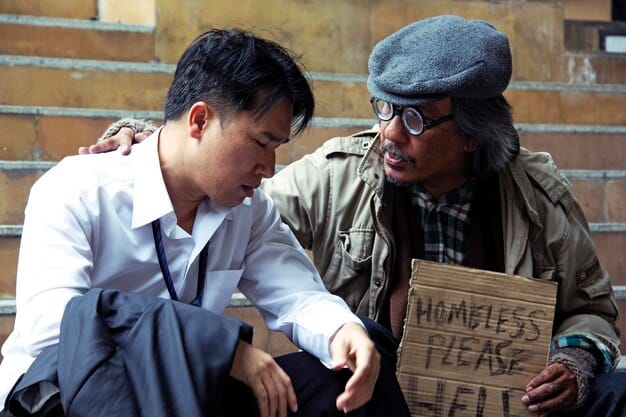US vs. Global Conflict Resolution: Key Cultural Differences

Cultural approaches to conflict resolution vary significantly worldwide, contrasting with the direct, individualistic methods often favored in the United States, and understanding these differences is crucial for effective intercultural communication.
Navigating disagreements is a universal human experience, yet the methods and meanings attributed to conflict resolution differ profoundly across cultures. While the underlying desire to restore harmony or find a solution is shared, the paths taken to achieve it can be strikingly distinct. Understanding these nuanced variations is essential for fostering more effective dialogue and collaboration across borders, making the question of What are the Key Differences Between US and Other Cultures’ Approaches to Conflict Resolution? more pertinent than ever.
understanding conflict: diverse lenses
The very definition of “conflict” can vary significantly across cultures. In some societies, open disagreement is seen as constructive and even necessary for progress. In others, it is considered disruptive, disrespectful, or a sign of failed relationships. This fundamental divergence in perception sets the stage for vastly different approaches to resolution.
The Western, particularly American, perspective often frames conflict as a problem to be solved directly, with clear winners and losers or a negotiated compromise. Communication tends to be explicit, and emotions may be outwardly expressed. The emphasis is frequently on individual rights and achieving a quick, efficient resolution.
direct vs indirect communication
A primary differentiator lies in communication styles. American culture typically favors direct communication, where messages are conveyed explicitly and “getting straight to the point” is valued. This contrasts sharply with many high-context cultures, where indirect communication is the norm, relying on subtle cues, context, and non-verbal signals.
- Direct Communication: Common in low-context cultures like the US, Germany, and Switzerland. Emphasis on clarity, literal meaning, and explicit articulation of thoughts and feelings.
- Indirect Communication: Prevalent in high-context cultures such as Japan, China, and many Middle Eastern and Latin American societies. Messages are implied, harmony is prioritized, and direct confrontation is often avoided to save face.
- Impact on Conflict: Direct communicators may perceive indirect approaches as evasive or dishonest, while indirect communicators might find directness aggressive or rude.
These differing modes of expression deeply influence how conflicts are initiated, discussed, and ultimately resolved. A direct approach might seek a face-to-face confrontation, whereas an indirect approach might involve intermediaries or subtle hints over time to convey displeasure or a desire for resolution without ever overtly stating a problem.
The cultural conditioning around communication impacts not only the words chosen but also the acceptable channels for expressing disagreement. In some cultures, direct verbal challenge to an elder or superior might be unthinkable, while in others, it could be seen as assertive and part of healthy debate.
individualism vs collectivism in resolution
Another fundamental cleavage in conflict resolution approaches stems from the cultural dimension of individualism versus collectivism. The United States is a strong proponent of individualism, emphasizing personal autonomy, self-reliance, and individual rights. This cultural trait deeply influences how conflict is perceived and managed.
In an individualistic framework, conflict resolution often centers on the individual’s grievances, needs, and desired outcomes. The focus is on finding a solution that satisfies the parties involved, with a strong emphasis on negotiation, compromise, and legal frameworks designed to protect individual interests. Rights and responsibilities are typically framed from an individual standpoint.
preserving group harmony
Conversely, many other cultures, particularly in Asia, Africa, and Latin America, lean towards collectivism. In these societies, the group’s needs, harmony, and reputation often supersede individual desires. Conflict is viewed not just as a disagreement between two individuals but as a potential threat to group cohesion and social order.
- Individualistic Approach: Prioritizes personal interests, rights, and achieving a swift, equitable solution for the individuals involved. Adversarial styles or direct negotiation are common.
- Collectivistic Approach: Focuses on maintaining social harmony, preserving relationships, and avoiding “loss of face” for all parties. Mediation, consensus-building, and indirect communication are often preferred.
- Implications: An individualistic approach might overlook the relational damage caused by conflict, while a collectivistic one might sacrifice individual needs for the sake of group peace, sometimes leading to unaddressed grievances.
The emphasis on group harmony in collectivistic cultures means that overt confrontation is often avoided. Resolutions are sought through channels that minimize public disagreement, preserve dignity, and ensure that relationships remain intact. The “win-lose” paradigm common in individualistic societies is often replaced by a “win-win” or “no-lose” approach, even if it delays resolution or makes it less clear-cut.
This difference has profound implications. For instance, an American negotiator might focus solely on the terms of a contract, while a counterpart from a collectivistic culture might prioritize establishing a trusting relationship first, viewing the contract as secondary to the interpersonal bond.
the role of hierarchy and power
Power dynamics and societal hierarchy play a significant, often unspoken, role in how conflicts are approached and resolved. In cultures with steep power hierarchies, challenging those in authority or expressing dissent openly can be seen as highly inappropriate, even rebellious.
In the US, while hierarchies exist, there is a general expectation of open communication and the right to challenge decisions, even from subordinates. This flatter hierarchical structure encourages individuals to voice opinions and seek direct resolution, irrespective of their position or status to a certain extent.
respect for authority and elders
Many other cultures, however, are deeply rooted in respect for elders, superiors, and established authority. In these contexts, conflicts involving power imbalances are handled with extreme caution. Direct challenges are rare, and solutions often involve deferring to or seeking guidance from those higher up in the hierarchy.
- Low Power Distance: Characteristic of the US and many Western European countries. There’s a tendency to question authority, engage in direct debate, and seek egalitarian solutions in conflict.
- High Power Distance: Common in many Asian, Latin American, and African cultures. Deference to authority is key; conflicts are often handled indirectly, by intermediaries, or through hierarchical channels to avoid disrespecting superiors.
- Consequences: Misunderstandings can arise when a low power distance individual directly addresses a high power distance superior in conflict, potentially causing offense or being perceived as insubordination.
The method of dispute resolution might also be dictated by hierarchy. For example, in some traditional societies, an elder or a village chief might serve as the ultimate arbiter, and their decision is accepted without question. This contrasts with a more legalistic approach often seen in the US, where formal mediation or court proceedings are common.
Acknowledging these power dynamics is crucial for effective intercultural conflict resolution. What might be considered a fair and open discussion in one culture could be interpreted as a disregard for proper protocol or extreme disrespect in another, escalating tensions rather than resolving them.

emotional expression and face-saving
The display and management of emotions during conflict are highly culturally determined. What is considered appropriate emotional expression in one culture might be seen as excessive or insufficient in another, directly impacting the resolution process.
In the US, there’s a relatively high tolerance for direct emotional expression during conflict, particularly frustration or anger, as long as it doesn’t escalate to physical violence. Expressing one’s feelings directly is often seen as a sign of authenticity and a necessary step towards resolution.
the concept of “face”
Many non-Western cultures, especially those rooted in collectivism, place immense importance on the concept of “face” (or mianzi in Chinese, honne/tatemae in Japanese). “Face” refers to one’s public image, dignity, and reputation, and its loss can have severe social consequences. Protecting one’s own face, and equally importantly, the face of others, is paramount during conflict.
- Overt Emotional Expression: More common in individualistic cultures. Emotions like anger or frustration may be openly displayed as a means of communication and to underscore the severity of a grievance.
- Restrained Emotional Expression: Pervasive in face-saving cultures. Emotions are often suppressed or communicated subtly to avoid disrupting harmony or causing embarrassment.
- Face-Saving Imperative: In these cultures, conflict resolution strategies are designed to allow all parties to save face, even if it means compromising on the “truth” or pursuing indirect solutions.
The need to save face means that direct confrontation, public shaming, or overtly “winning” a conflict at someone else’s expense is generally avoided. Instead, solutions are sought that allow all parties to exit the situation with their dignity intact. This might involve indirect apologies, subtle concessions, or agreements that are implicitly understood rather than explicitly stated.
Misinterpreting emotional cues can lead to further conflict. An American might perceive a lack of overt emotion as indifference, while a person from a face-saving culture might see an American’s open display of anger as extremely offensive and a direct attack on their dignity.
third-party intervention and legal frameworks
The preferred role of third parties in conflict resolution is another key differentiator. In the US, formal legal systems and professional mediators are often the default recourse for disputes that cannot be resolved directly between parties.
The American legal system provides a structured, often adversarial, framework for resolving disputes. Litigation, arbitration, and formal mediation are well-established processes, emphasizing legal rights, evidence, and objective judgment, aiming for a binding and enforceable outcome.
community elders and informal mediation
In contrast, many cultures prioritize informal, community-based, or traditional methods of dispute resolution. This can involve revered elders, respected community leaders, or family figures acting as mediators, whose authority is derived from their social standing rather than formal qualifications.
- Formal Legal Systems: Predominant in the US and Western contexts. Emphasis on legal rights, precedent, and formal processes like litigation, mediation, and arbitration.
- Informal / Traditional Mediation: Preferred in many non-Western cultures. Relies on social norms, community values, and the authority of respected individuals (e.g., elders, religious leaders) to guide resolution.
- Admissibility: In some cultures, resorting to formal legal channels might be seen as a failure of social ties or an extreme measure, while in the US, it’s often a common first step for significant disputes.
These informal systems often prioritize restoration of relationships, social harmony, and reconciliation over strict adherence to legal precedents or absolute “justice” as defined by Western legal codes. The solutions sought might not be legally binding in a Western sense but carry significant social weight and moral obligation.
Furthermore, the notion of justice itself can differ. While Western systems often focus on compensatory or retributive justice, many indigenous and traditional systems emphasize restorative justice, aiming to heal the damage caused by the conflict and reintegrate parties into the community.
time orientation and pace of resolution
The perception and use of time also significantly influence conflict resolution. In some cultures, time is viewed as linear and finite, leading to a desire for quick, efficient resolutions. In others, time is more fluid, allowing for a more deliberate, long-term approach.
American culture is typically monochronic, valuing punctuality, schedules, and efficiency. This often translates into a desire to “get to the point” in negotiations and resolve conflicts swiftly, setting deadlines and expecting prompt follow-through.
patience and process over speed
Many other cultures, particularly polychronic ones, view time more holistically and relationally. Building relationships, engaging in extensive discussion, and allowing a resolution to emerge organically are often prioritized over speed. Patience is a virtue, and rushing the process can be counterproductive.
- Monochronic (Linear) Time: Characteristic of the US, Germany. Conflicts are expected to be addressed directly, and resolved efficiently, often within set timeframes.
- Polychronic (Fluid) Time: Prevalent in Latin American, Middle Eastern, and many Asian cultures. The process of resolution is often as important as the outcome, requiring patience, relationship-building, and allowing time for consensus to form.
- Miscommunication: An American’s desire for a quick resolution might be seen as impatient or disrespectful, while a polychronic approach might be perceived as indecisive or a delay tactic.
In cultures with a more fluid perception of time, repeated meetings, extensive dialogue, and even social gatherings might be part of the “resolution process,” aiming to rebuild trust and ensure all perspectives are thoroughly considered before any formal agreement. This iterative process can be frustrating for those accustomed to more direct and time-bound negotiations.
Understanding this temporal dynamic is critical. What an American might perceive as dragging feet, a counterpart from a polychronic culture might see as necessary due diligence for a sustainable and relationship-preserving resolution.

The journey to effective cross-cultural conflict resolution is paved not only with good intentions but also with a deep understanding of these underlying cultural scripts. While the American approach champions directness, individuality, and efficiency, many other cultures prioritize harmony, indirectness, and long-term relational well-being. Recognizing these fundamental differences is the first step towards building bridges rather than walls when disagreements arise across diverse cultural landscapes.
| Key Aspect | Brief Description |
|---|---|
| 🗣️ Communication Style | US often direct; many other cultures prefer indirect, contextual cues for harmony. |
| 👤 Individual vs. Group | US emphasis on individual rights; others prioritize group harmony and relationships. |
| 🎭 Face-Saving & Emotions | US more open with emotions; many cultures prioritize dignity and avoid public embarrassment. |
| ⏳ Resolution Pace | US seeks quick resolutions; some cultures prefer longer, relationship-building processes. |
frequently asked questions about conflict resolution
▼
The US generally favors direct, explicit communication, where issues are confronted head-on. Many other cultures, particularly high-context ones, prefer indirect communication, relying on non-verbal cues, context, and intermediaries to preserve harmony and avoid direct confrontation, which can be seen as rude or aggressive.
▼
In the individualistic US, conflict resolution often focuses on individual rights, needs, and achieving personal satisfaction or compromise. In collectivist cultures, the emphasis shifts to maintaining group harmony, preserving relationships, and avoiding “loss of face” for all parties involved, often prioritizing collective well-being over individual desires.
▼
In the US, generally lower power distance allows for more direct challenges to authority. In high power distance cultures, deference to superiors is crucial; conflicts involving hierarchical differences are often handled indirectly, through trusted intermediaries, or by senior figures, to maintain respect and avoid insubordination.
▼
“Face-saving” refers to preserving one’s dignity and reputation, and that of others. In many non-Western cultures, publicly losing face can have severe social consequences. Therefore, conflict resolution strategies are often subtle, indirect, and designed to allow all parties to maintain their pride and avoid public embarrassment, even at the cost of directness.
▼
The US often has a monochronic view of time, valuing quick, efficient resolutions. Many other cultures (polychronic) view time more fluidly, prioritizing relationship-building, thorough discussion, and a gradual, organic consensus. Rushing the process in these cultures can be seen as disrespectful or detrimental to reaching a sustainable agreement.
conclusion
As we navigate an increasingly interconnected world, understanding the intricate tapestry of cultural differences in conflict resolution is no longer merely academic; it is a vital skill. From the direct communication often favored in the United States to the nuanced, harmony-preserving approaches found in many other societies, these distinctions shape how disputes arise, are perceived, and are ultimately addressed. Embracing this diversity, rather than imposing a single framework, paves the way for more meaningful dialogue, stronger relationships, and truly effective cross-cultural understanding. For practitioners, diplomats, and global citizens alike, cultivating this cultural intelligence is the cornerstone of fostering peace and collaboration in our complex global landscape.





